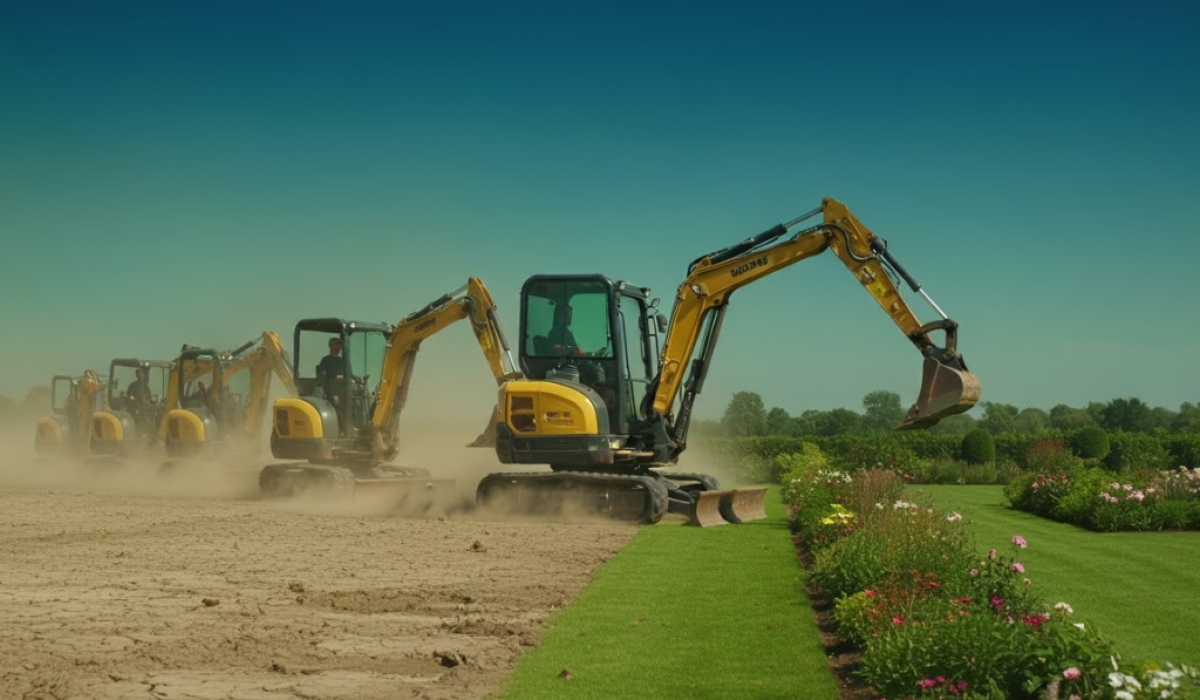Compact excavators, or mini excavators, are machines that have had a profound impact on the construction and landscaping industries and have become the most flexible and efficient way to solve various tasks.
With machines being small in size (usually from 1 to 10 tons), they are able to work in tight spaces where large excavators are not able to operate at ease.
Such a small body does not at all affect the power of the machine; in fact, most of the models in the market have hydraulic systems which with the only touch of the button will deliver a superb performance.
The rise in the demand for compact excavators owes greatly to the fact that these machines can be powerful, precise, and portable at the same time thus making them indispensable for contractors, landscapers, and utility workers.
The first compact excavators were designed during the late part of the 20th century when the market started asking for small and more agile tooling.
As the urban areas became built-up, and the construction sites got congested the demand for machines capable of performing by passing through narrow spaces but still their performance remained the same, was seen.
The manufacturers did not only create the machinery that met the demand but also came up with different add-ons and traits which fueled the growth of the compact excavators market.
Nowadays, these machines are fully equipped with the latest technology, which not only includes the machine’s performance systems but also has software with smart controls, and energy-saving motors, whereas, these machines now become the key elements of the modern style of construction.
Key Takeaways
- Compact excavators are really cool and tough machines which are used for digging, lifting, and demolition in construction and landscaping projects.
- The great thing about compact excavators is that they can be, thanks to their small size, maneuverability, and the possibility to work in tight spots, as well as, the efficiency and cost-effectiveness, the best solution for solving certain problems.
- There are several different types and models of compact excavators, e.g. mini, midi, and wheeled machines which are not only different in size but also in performance and technical specifications.
- Compact excavators are equipped with different facilities and tools such as hydraulic systems, attachments, and operator controls which definitely can improve not only their power and efficiency but the whole range of jobs that a person can perform at the construction site or on any other site where the machines are also suitable.
- To extend the life and maintenance of compact excavators like regular check-ups, oiling, and washing are the best practices required.
Advantages of Using Compact Excavators
Multi-Tasking Capabilities
The machines are pretty solid with a variety of equipment. For instance, they come with buckets, drill bits, and hydraulic breakers but also tons of other equipment, that’s how they can perform a huge number of tasks on just one job site.
So, very flexible – it doesn’t always require a lot of different machines and it facilitates the construction side in terms of the whole job, which includes excavation, grading, trenching, even – rock breaking was we do it in a fraction of the time.
Easy Transportation and Setup
Compact excavators have generally some low weight and can be driven on the trailer very comfortably or a truck can be used to transport them, transport permits will maybe not due so far.
In such a situation, the big advantage, in particular, is that the tenders can either work not only at one place but also be frequently changing their place of work. Furthermore, many compact excavators are designed with collapsible or detachable parts, so their transportability is further increased.
Time-Saving Operations
By utilizing this innovation, the workers’ job of setting up and dismantling the machine is made easier, and as a result, a significant amount of time lost during the changeovers between projects is recovered.
Types and Models of Compact Excavators
The market for compact excavators is full of variety as many manufacturers have different models that are specially designed for specific applications and user needs. Recognizable brands are Caterpillar, Bobcat, Kubota, and John Deere. Various models in their product lines differ primarily in size, power output, and features.
As an illustration of this, the Caterpillar 302.7 CR is preferred by a great number of contractors because of its small size that is paired with the high levels of its performance that together make the machine the best option for urban construction projects work mostly in tight places.
Some manufacturers have even built specialized compact excavators besides their traditional ones. The latter variety e.g. zero-tail-swing is uniquely able to rotate within the area occupied just by the tracks and, consequently, the machines are small and extremely perfect for work in confined spaces.
On the other hand, lengthy arm excavators are created for tasks that are away from the operators, like dredging work or deep excavation. Offering customers such specialized models as well as a selection of the standard, traditional models to better fit their specific tasks, further result in boosting up the productivity and efficiency at the construction site.
Features and Functions of Compact Excavators
Similar to the Feature Functions Categorization of Compact Excavators Compact Excavator Features Functions Compact Size Easy maneuverability in tight spaces Hydraulic System Powerful source for doing digging and lifting .
At the same attachments Versatility for different tasks like digging, trenching, and lifting Cabin Comfort Friendly to the operator’s design for long hours of work control Systems handling and performance to be done accurately and punctually Small on one side, heavy in tasks
Manufacturers of compact excavators incorporate a multitude of characteristics that enhance their capability and convenience. One of the features that deserve special mention is the state-of-the-art hydraulic system that is responsible for ensuring the attachments’ power supply and delivers lifting capability that is far superior to anything else.
Many of the new compact excavators have variable flow hydraulics that enable the operators to set the flow rate according to the required device.
As a result, the system can serve a variety of functions and perform to the best of its abilities. Another noteworthy characteristic of the topic is its well-thought-out handling.
For the most part, joystick elements found in these kinds of equipment are of optimal design and ensure that precise handling is always achieved.
In fact, nowadays, some manufacturers are designing equipment that have one or another advanced feature such as the application of proportional controls to continuous attachments.
To add further, the majority of compact excavators are equipped with user-friendly displays that give performance feedback, fuel gauging, and timely information on maintenance needs. Apart from these virtues, these are also operator-friendly features that contribute to the safety and efficiency of the entire job site.
Compact Excavator Upkeep and Maintenance
The sustainability and efficiency of compact excavators greatly depend on proper care and maintenance. Routine checks must be performed to maintain a good level of fluid, including engine oil, hydraulic fluid, and antifreeze.
Filters should be frequently checked and replaced if necessary to sweep off the clogging that could otherwise lead to the engine’s bad performance.
Moreover, an essential thing to do is to have a look at wear parts such as tracks or tires; the timely replacement can help avoid more significant problems in the future.
Follow the schedule of the manufacturer to make sure that the intervals of maintenance service are respected. This typically consists of greasing joints, testing the electrical systems, and other ordinary activities.
Today, many compact excavators are equipped with diagnostic systems which can recognize potential problems and alert the operators before they become major ones.
Operators can still maintain the reliability and efficiency of their machines throughout the entire operational life if they carry out regular maintenance and repair minor faults.
Safety Tips for Operating Compact Excavators
Proper Training and Familiarization
The first and important safety tip is that all the operators are well-trained for the task and acquainted with the model they will be using. The training should not only be on the operating procedures but also on the safety protocols such as the correct use of personal protective equipment (PPE) which includes hard hats, gloves, and steel-toed boots among others.
Pre-Operation Inspection and Awareness
Before they start performing any excavation job, operators have to carry out a detailed check of the machine to check its current state in a pre-operation inspection surging.
This not only involves identifying any leaks in the hydraulic lines and ensuring that any safety guards are in place but it also requires one to ascertain that all controls are working properly.
Moreover, the operators should always be alert to the surroundings; this means they should be able to discern the overhead power lines and other dangerous objects near them.
Applications and Uses of Compact Excavators
Compact excavators are used in various situations because of their high versatility and efficiency. Construction commonly uses compact excavators for tasks such as digging foundations, trenching for utilities, and grading surfaces.
Their ability to operate in constrained spaces is the main reason why they are mostly used in urban environments where larger machines could not work.
Even landscapers can find compact excavators to be useful when conducting tasks such as planting trees or shrubs, grading land for new gardens, or installing drainage systems. The accuracy that comes with the machines allows the landscapers to complete intricate designs with minimal disruption to the environment.
Not only that, but compact excavators are now commonly used in wetland restoration or site remediation projects because they can move through delicate areas without causing severe damage.
Future Developments in Compact Excavator Technology
With the continuous march of technology, there are plenty of exciting advancements in the future of compact excavators that could be projected.
One of the areas of the most importance is automation; manufacturers are looking at integrating unmanned functions into compact excavators that would increase productivity and decrease operator fatigue.
To illustrate, in the case of automatic digging, the machines would be able to do the job without getting tired of people’s constant reproaching.
Another significant trend that emerges in the construction industry is the transition to sustainability. A lot of the manufacturers are making their investments in electric or hybrid machines to tackle the exhaust and fuel problems, while maintaining the initial performance of diesel-powered machines.
Positively, these eco-friendly options can be helpful in achieving global sustainability goals and saving the cost way because of the less wastage of fuel through the years.
More, the telematics technology has been evolving and is going to be the force to reckon with in the way of monitoring and managing compact excavators on site.
The real-time collection of performance data allows for the operators to strategize usage patterns and schedule maintenance in a more optimal way. This trend, driven by data, is designed to increase efficiency and unavailability in a variety of sectors.
To sum up, compact excavators are indispensable in today’s construction and landscaping environments due to their versatility, efficiency, and adaptability across various sectors.
The technological development will increase the significance of these machines both for the customer and our environment by making them suitable for a new industry landscape constantly changing.





